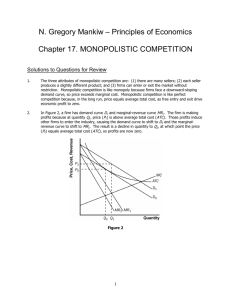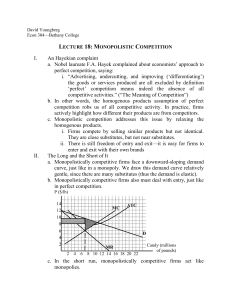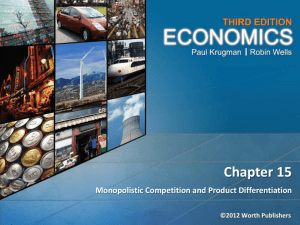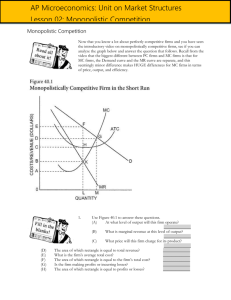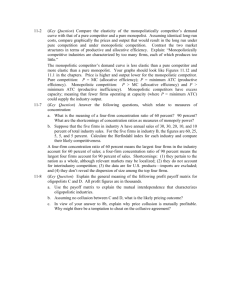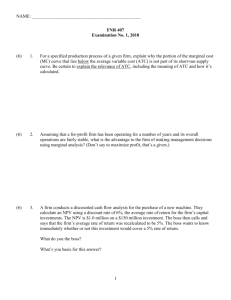The Study of Economics
advertisement
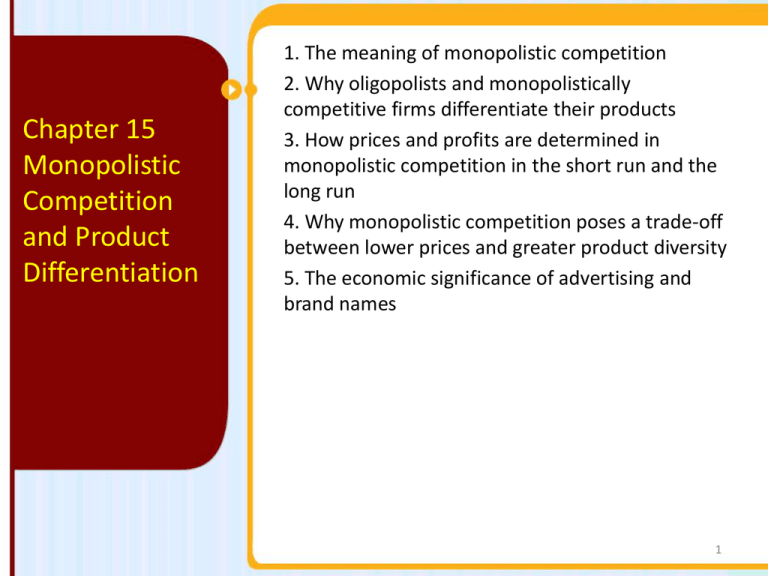
Chapter 15 Monopolistic Competition and Product Differentiation 1. The meaning of monopolistic competition 2. Why oligopolists and monopolistically competitive firms differentiate their products 3. How prices and profits are determined in monopolistic competition in the short run and the long run 4. Why monopolistic competition poses a trade-off between lower prices and greater product diversity 5. The economic significance of advertising and brand names 1 The Meaning of Monopolistic Competition Monopolistic competition is a market structure in which there are many competing producers in an industry each producer sells a differentiated product there is free entry into and exit from the industry in the long run Product differentiation plays an even more crucial role in monopolistically competitive industries. Why? Tacit collusion is virtually impossible when there are many producers. Hence, product differentiation is the only way monopolistically competitive firms can acquire some market power. How do firms in the same industry—such as fast-food vendors, gas stations, or chocolate companies—differentiate their products? Is the difference mainly in the minds of consumers or in the products themselves? Product Differentiation There are three important forms of product differentiation: 1) Differentiation by style or type – sedans vs. SUVs 2) Differentiation by location – dry cleaner near home vs. cheaper dry cleaner far away 3) Differentiation by quality – ordinary chocolate ($) vs. gourmet chocolate ($$$) Whatever form it takes, however, there are two important features of industries with differentiated products: Competition among sellers: Producers compete for the same market, so entry by more producers reduces the quantity each existing producer sells at any given price. Value in diversity: In addition, consumers gain from the increased diversity of products. Understanding Monopolistic Competition As the term monopolistic competition suggests, this market structure combines some features typical of monopoly with others typical of perfect competition: Because each firm is offering a distinct product, it is in a way like a monopolist: it faces a downward-sloping demand curve and has some market power—the ability within limits to determine the price of its product. However, unlike a pure monopolist, a monopolistically competitive firm does face competition: the amount of product it can sell depends on the prices and products offered by other firms in the industry. The MC Firm in the Short Run The following figure shows two possible situations that a typical firm in a monopolistically competitive industry might face in the short run. In each case, the firm looks like any monopolist: it faces a downwardsloping demand curve, which implies a downward-sloping marginal revenue curve. We assume that every firm has an upward-sloping marginal cost curve, but that it also faces some fixed costs, so that its average total cost curve is U-shaped. The MC Firm in the Short Run Price, cost, marginal revenue Price, cost, marginal revenue (a) A Profitable Firm MC (b) An Unprofitable Firm MC ATC P P ATC ATC U P Loss U Profit ATC P MR P Q P Profit-maximizing quantity D P Quantity D U MR U Q U Loss-minimizing quantity Quantity Monopolistic Competition in the Long Run If the typical firm earns positive profits, new firms will enter the industry in the long run, shifting each existing firm’s demand curve to the left. If the typical firm incurs losses, some existing firms will exit the industry in the long run, shifting the demand curve of each remaining firm to the right. In the long run, equilibrium of a monopolistically competitive industry, the zero-profit-equilibrium, firms just break even. The typical firm’s demand curve is just tangent to its average total cost curve at its profit-maximizing output. Entry and Exit Shift Existing Firm’s Demand Curve and Marginal Revenue Curve Price, marginal revenue Price, marginal revenue (a) Effects of Entry Entry shifts the existing firm’s demand curve and its marginal revenue curve leftward. MR 2 MR 1 D 2 D 1 Quantity (b) Effects of Exit Exit shifts the existing firm’s demand curve and its marginal revenue curve rightward. MR 1 MR D1 2 D 2 Quantity 7 FOR INQUIRING MINDS HITS AND FLOPS On the face of it, the movie business seems to meet the criteria for monopolistic competition. Movies compete for the same consumers; each movie is different from the others; new companies can and do enter the business. But where’s the zero-profit equilibrium? After all, some movies are enormously profitable. The key is to realize that for every successful blockbuster, there are several flops—and that the movie studios don’t know in advance which will be which. The difference between movie-making and the type of monopolistic competition we model in this chapter is that the fixed costs of making a movie are also sunk costs—once they’ve been incurred, they can’t be recovered. 8 FOR INQUIRING MINDS HITS AND FLOPS Yet, there is still, in a way, a zero-profit equilibrium. If movies on average were highly profitable, more studios would enter the industry and more movies would be made. If movies on average lost money, fewer movies would be made. In fact, as you might expect, the movie industry on average earns just about enough to cover the cost of production—that is, it earns roughly zero economic profit. 9 The Long-Run Zero-Profit Equilibrium Price, cost, marginal revenue MC Point of tangency ATC Z P = ATC MC MC MR Q MC D MC MC Quantity 10 Monopolistic Competition versus Perfect Competition In the long-run equilibrium of a monopolistically competitive industry, there are many firms, all earning zero profit. Price exceeds marginal cost, so some mutually beneficial trades are unexploited. The following figure compares the long-run equilibrium of a typical firm in a perfectly competitive industry with that of a typical firm in a monopolistically competitive industry. Comparing LR Equilibrium in PC and MC Price, cost, marginal revenue Price, cost, (b) Long-Run Equilibrium in Monopolistic Competition marginal revenue (a) Long-Run Equilibrium in Perfect Competition MC ATC MC ATC P = ATC MC MC PPC = MC = PC ATC PC D=MR =P PC MC MC Q PC Minimum-cost output Quantity MR MC Q MC D MC Quantity Minimum-cost output 12 Is Monopolistic Competition Inefficient? Firms in a monopolistically competitive industry have excess capacity: they produce less than the output at which average total cost is minimized. Price exceeds marginal cost, so some mutually beneficial trades are unexploited. The higher price consumers pay because of excess capacity is offset to some extent by the value they receive from greater diversity. Hence, it is not clear that this is actually a source of inefficiency. Controversies About Product Differentiation No discussion of product differentiation is complete without spending at least a bit of time on the two related concepts: advertising and brand names. The Role of Advertising In industries with product differentiation, firms advertise to increase the demand for their products. Advertising is not a waste of resources when it gives consumers useful information about products. Advertising that simply touts a product is harder to explain. Either consumers are irrational, or expensive advertising communicates that the firm's products are of high quality. Brand Names Some firms create brand names. A brand name is a name owned by a particular firm that distinguishes its products from those of other firms. As with advertising, the social value of brand names can be ambiguous. The names convey real information when they assure consumers of the quality of a product. ECONOMICS IN ACTION Absolut Irrationality Vodka is aquavit, the most unsophisticated type of alcohol. It is bland, with no taste, no smell, and many brands are comparable. How then are products differentiated? Advertising!!! Consider Absolut vodka, whose magnetic advertising campaign has led to huge popularity for their brand. In Sweden (where Absolut is made), the locals prefer cheaper brands. This is because alcohol advertising is against the law in Sweden. 16 VIDEO TED TALK: Malcolm Gladwell on spaghetti sauce: http://www.ted.com/talks/malcolm_gladwell_on_spaghetti_s auce.html 17
